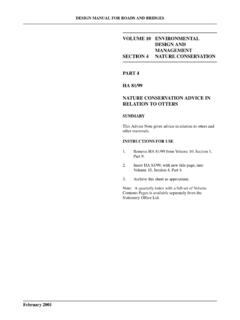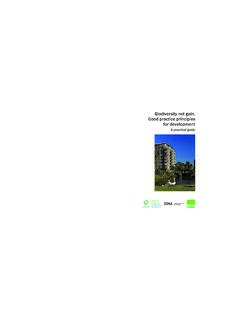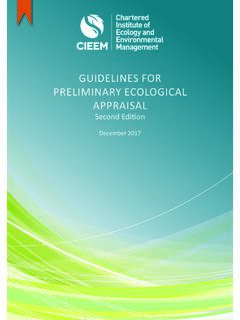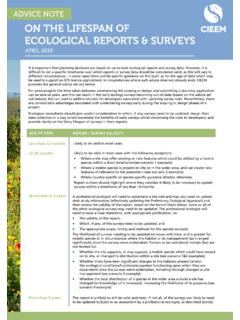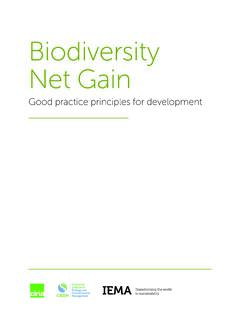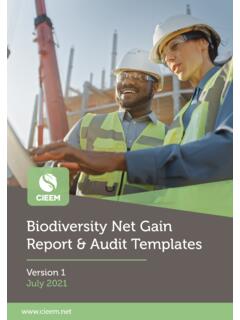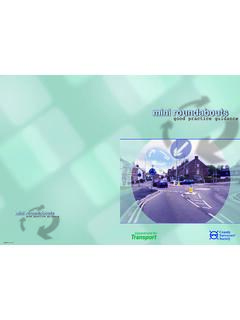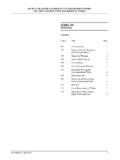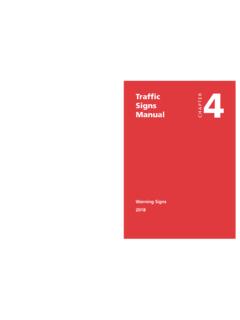Transcription of GUIDELINES FOR ECOLOGICAL REPORT WRITING
1 GUIDELINES FOR ECOLOGICAL REPORT WRITINGS econd EditionDecember 2017 Contents1. DIFFERENT TYPES OF REPORT FOR DIFFERENT GENERAL ADVICE ..4. MAKING A GENERIC CHECKLIST FOR REPORT STRUCTURE .. Title List of Contents, Figures, Tables and Introduction and Terms of Discussion and Analysis of Other COMMON OTHER USEFUL Appendix A - Template for Preliminary ECOLOGICAL Appraisal Appendix B - Template for ECOLOGICAL Impact Assessment Professional Standards Committee would like to acknowledge the members of the working group who undertook the review of the Institute s previous publication on ECOLOGICAL REPORT WRITING (Professional Guidance Series No. 9) and who were instrumental in bringing forward these new GUIDELINES as a replacement to that original document.
2 They include: Phil Baarda, Jessica Batchelor, Mick Hall, Pauline Holmes, Mike Dean, Richard Graves, Lisa Kerslake, Mike Oxford, Charlotte Phillips and Sue document should be referenced as:CIEEM (2017) GUIDELINES on ECOLOGICAL REPORT WRITING . Chartered Institute of Ecology and Environmental Management, The ability to provide objective, relevant, accurate, fair and impartial information and advice is enshrined in the Institute s Code of Professional Conduct (the Code) and is an essential requirement if members are to demonstrate their competence and professionalism. Good REPORT WRITING is therefore an essential skill for professional ecologists and environmental managers. A well-written REPORT is succinct, serves the purpose for which it is intended, is tailored to the requirements of the reader and answers the brief agreed with the client.
3 It should inspire the reader s confidence in the content, it should avoid any misunderstanding, and minimise the risk of unintended financial or legal consequences. The intention with these GUIDELINES is to provide a framework for the preparation of a good This guidance is based on established good practice and aims to ensure:a. Ease of access to readily available information;b. Content and structure serve the intended purpose ( contains all necessary information in a logical format);c. Transparency and clarity throughout and justification for robust recommendations and DIFFeRent tYPes oF REPORT FoR DIFFeRent From the outset, it is important to identify the purpose of the REPORT and to then decide on the most appropriate format that will best serve that purpose.
4 The type of REPORT required will vary depending on the client and their specific needs, and on a project by project basis. For example, the REPORT may cover a single survey for one particular species or be a full ECOLOGICAL assessment involving multiple, detailed species and habitat surveys, accompanied by an assessment of likely impacts, with details of necessary mitigation measures. Table 1 provides a list of common types of REPORT along with a description of the purpose each is intended to serve. To accompany the table, two templates are provided in Appendix A and B of these GUIDELINES that set out the structure and format that is considered to be good practice when preparing ECOLOGICAL Impact Assessment (EcIA) Reports and Preliminary ECOLOGICAL Appraisal Reports (PEARs) (for the latter see CIEEM s Technical Guidance Series (TGS) GUIDELINES for Preliminary ECOLOGICAL Appraisal on the Institute s website).
5 Some clients, such as national and local highway agencies/authorities and Network Rail may already have a preferred structure and format for reports to be submitted to them ( as set out respectively in the Design Manual for Roads and Bridges ( dmrb ) and the Guide to Rail Investment Process (GRIP)). Otherwise, under normal circumstances where a REPORT is intended to inform some stage of the planning and development process, ECOLOGICAL reports should be based on the templates provided in Appendix A and B of these These GUIDELINES provide general advice applicable to the majority of reports. However, for detailed guidance on undertaking and reporting on ECOLOGICAL Impact Assessments (EcIAs), see CIEEM s GUIDELINES for ECOLOGICAL Impact Assessment on the Institute s Importance of It is important to remember that the structure and content of a REPORT should be proportionate to the predicted degree of risk to biodiversity and to the nature and scale of the proposed development.
6 Consequently, REPORT authors should only provide information that is relevant, necessary and material to the purpose identified, while at the same time ensuring that adequate details are provided for the intended reader and/or audience in the case of an EcIA REPORT , a local planning authority (LPA). Likewise, all decision-makers should apply a proportionate approach to the information that they 1. Examples of different types of ECOLOGICAL REPORT and their purposeReport TypeDescription/PurposeSurvey and Research ReportsEcological Survey ( Habitat Survey)Provides the results of an ECOLOGICAL survey, such as a habitat or a badger survey. The REPORT will include a description of the methods used as well as the detailed results of the survey, and interpretation/assessment of the results.
7 These reports are normally used to inform one of the reports listed under Assessment . They may be submitted as part of a planning application as an appendix to an EcIA REPORT or the ECOLOGICAL chapter of an Environmental Statement (see below). ECOLOGICAL Survey reports should follow the structure set out in Section 5 below. Research REPORT Provides the results of a piece of research, such as may be commissioned by a Statutory Nature Conservation Organisation (SNCO). A specific structure may be provided in such cases by the client. Alternatively, preparation of such reports may follow the guidance in Section 5 below. ECOLOGICAL Monitoring REPORT (As distinct from a monitoring strategy see below)Provides the results of post-construction monitoring for a development project as a snap shot at a particular period in time, as required by a planning condition/obligation or by a protected species licence.
8 The REPORT will include a description of the methods used as well as the detailed results of the survey, and interpretation/ assessment of the results. Preparation of the monitoring REPORT should, where appropriate, follow the guidance on REPORT structure set out in Section 5 below. The appropriate content of such a REPORT is set out in BS42020 clause monitoring REPORT is distinct from an ECOLOGICAL monitoring strategy . The former provides only the methods and results of monitoring, along with their interpretation (often collected at prescribed periods after the completion of works). Whereas, the full strategy provides an agreed set of aims and objectives for monitoring and comprehensive details about how monitoring will be undertaken and reviewed (see ECOLOGICAL Monitoring Strategy below under Other Common Types of ECOLOGICAL REPORT ).
9 Assessment ReportsPreliminary ECOLOGICAL Appraisal REPORT (PEAR)Provides the results of initial ECOLOGICAL surveys associated with a proposed development. The REPORT is used to identify further ECOLOGICAL surveys necessary to inform an EcIA (see below), to identify ECOLOGICAL constraints to a project and make recommendations for design changes, and to highlight opportunities for ECOLOGICAL enhancement. It can be used as a scoping REPORT (for non-EIA projects), but should not be submitted as part of a planning application unless it can be determined that the project would have no significant ECOLOGICAL effects, no mitigation is required and no further surveys are necessary; with the exception of such cases it should be superseded by an EcIA REPORT (see below).
10 The PEAR should follow the structure set out in Appendix A of these GUIDELINES . 2 ECOLOGICAL Impact Assessment (EcIA) REPORT - non-EIAA ssesses the impacts of a non-EIA development proposal on ECOLOGICAL features, clearly identifying any significant effects as well as impacts on any designated sites or protected species, and detailing both the mitigation measures required, and how these will be secured. An EcIA REPORT will be submitted as part of a planning application where it has been determined that a formal EIA is not required. It should follow the structure set out in Appendix B of these GUIDELINES . For development projects affecting only a single species/group (such as where a barn conversion requires an assessment in relation to bats) the REPORT accompanying the application will comprise an EcIA REPORT .
